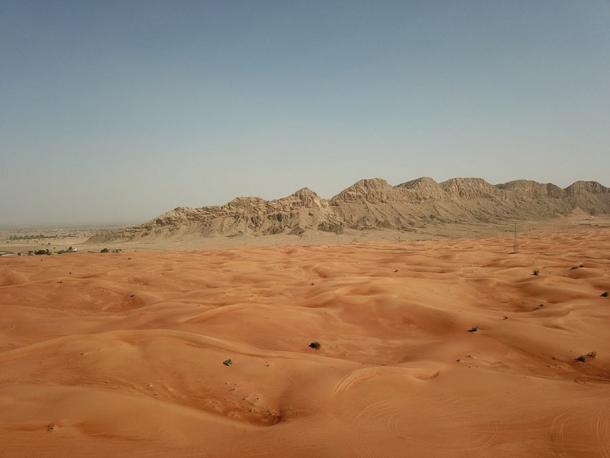
Paleolithic Humans Were Much More Adaptable Than Thought
Using the very latest in archaeological dating technology, an international team of researchers has discovered that human beings were living on the Arabian Peninsula tens of thousands of years earlier than had previously been believed. Furthermore, they were able to maintain their occupation of the region during even the driest and most inhospitable climatological periods, which was yet another surprise that emerged from this innovative and revolutionary new research.

The study found that Paleolithic humans were more adaptable to climate change than previously thought. (Kovalenko I / Adobe Stock)
Paleolithic Humans in the Middle East
This updated understanding of prehistoric history in the Middle East emerged from a new study of an important Paleolithic site known as Jebel Faya. Located near the city of Sharjah in the United Arab Emirates, this expansive rock shelter was occupied by humans over a long period of time during the Paleolithic period. Excavations back in 2009 proved that people had been living there as long as 125,000 years ago, which made Jebel Faya the oldest known occupied site in all of Arabia.
- Arabian Peninsula Was a Hotbed of Hominin Cultures 400,000 Years Ago
- Footprints Reveal Passage of Early Humans From Africa Through Arabia
But as the scientists responsible for the new research explain in an article published in the journal Scientific Reports, it turns out Jebel Faya was occupied even earlier than this. With a full arsenal of cutting-edge archaeological tools at their disposal, a team of experts led by Dr. Knut Bretzke, an archaeologist from the University of Tübingen in Germany, and Dr. Frank Preusser, a geologist from the University of Freiburg, found that people were actually residing in the shelter as long as 210,000 years ago.
There were four distinct phases of occupation at the site, the scientists determined, which began at that ancient date and continued until approximately 120,000 years ago. Contrary to past expectations this occupation was shown to have been continuous and did not vary based on fluctuations in the Arabian climate. Even when it got extremely hot and dry people stayed, and they survived despite the odds being against them.

Jebel Faya, seen from the desert East of the range. (Alexandermcnabb / CC BY-SA 4.0)
The Astounding Adaptability of the Human Species
Previously, scientists who study prehistoric ecology and human society were convinced humans wouldn’t have been able to survive in Arabia during its dry climate phases. The theory was that they must have come and gone from the Arabian Peninsula at various times, leaving when it was too hot and dry and returning when rainfall increased. But this idea has now been proven incorrect. Humans apparently continued to live in the shelter at Jebel Faya even when conditions outside were harsh, showing a level of adaptability that is beyond what they were previously thought to have possessed.
According to Professor Adrian Parker, a geographer from Oxford Brookes University who led the reconstruction of the ancient climate at Jebel Faya, existing ideas about the complex connections between climate, environment, and human settlement in Paleolithic Arabia will need to be reevaluated.
“Our data challenge previous assumptions that human occupation in Arabia was only confined to well-defined wetter climate phases,” he said, in a University of Freiburg press release covering the new study. “Understanding the environmental context is paramount when evaluating human occupation.”
For his part, team leader Bretzke believes that further study of Jebel Faya and its surroundings will produce more surprising data about the relationship between human occupation patterns and environmental variance. “Most exciting for me personally is that our data provides first evidence for human occupation of Arabia 170,000 years ago,” he said.
“This period is traditionally thought to be characterized by extremely dry conditions that must have prevented human presence in Arabia. We think that the unique interplay of human behavioral flexibility, the mosaic landscapes of South-East Arabia and the occurrence of brief spells of more humid conditions enabled the survival of these early human groups.”

Stone artifacts discovered at Jebel Faya which have provided evidence of paleolithic human occupation. (Bretzke et. al. / Scientific Reports)
Climate Change Then vs. Climate Change Now: What Can We Learn?
It seems that humans experienced severe levels of heat and drought in Arabia during the Paleolithic period, yet were still able to survive. “The study from Jebel Faya is another milestone in enlightening the complex history of our species,” said Professor Preusser.
It is natural to draw a connection between ancient climate change in Arabia and that which is occurring today. But Professor Preusser urges caution before taking this approach. There are important differences, he says, between the climate-related challenges humans faced in the past and those they must confront in the present.
For example, during the Paleolithic period, notable climate change in Arabia would have occurred only over the course of several centuries. In the present, significant shifts may be experienced in just decades, assuming the current climate change models are correct.
Another difference is that climate change in the modern era would be global and would therefore impact some areas (coastal regions, desert areas where life is already difficult, etc.) more severely than others. Consequently, it might be possible to adapt in some places, but almost impossible to do so in others.
- New Study Reveals Ancient Arabian Peninsula Funerary Avenues Network
- Ice Age Galileans Thrived During Global Ice Melts
What the new research shows is that even 170,000 years ago, Paleolithic humans were hardy, flexible, and inventive, especially when their survival was at stake. This knowledge is something to hold onto, as we contemplate the climate changes that may be coming in the decades ahead.
“(Though) it is clear that climate change will cost many lives, have a major impact on the environment and may even make some parts of the planet uninhabitable, our ancestors could adapt to climate change, and I am sure the human race will not disappear even during the worst scenarios predicted,” concluded Professor Preusser.
Top image: Excavations at Jebel Faya Rock Shelter, once home to Paleolithic humans. Source: Knut Bretzke
By Nathan Falde















